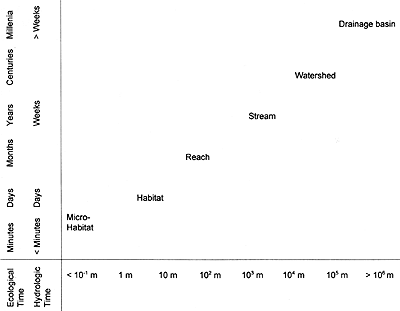 |
 |
Self-Correcting Mechanisms and Dynamic Equilibrium
Stream corridors exhibit a dynamic form of stability, known as dynamic equilibrium. Dynamic equilibrium refers to the ability of system to persist within a range of conditions (Federal Interagency Stream Restoration Work Group, 1998). Maintaining this balance requires the presence of a series of self-correcting mechanisms in the ecosystem. A disturbance to the stream ecosystem triggers a response from these self-correcting mechanisms allowing maintenance of the dynamic equilibrium.
Disturbances result from both naturally occurring and human-induced events. Climatic factors often play a role in naturally occurring disturbances and generally involve below- or above-normal precipitation and concomitant runoff. Human-induced disturbances often relate to changing land use patterns associated with development activities within the watershed.
Disturbances and the river systemís response to them occur at both temporal and spatial scales, and a crude correlation can be drawn between them (Figure 1.9). At the stream reach scale, for example, cumulative effects of wave action from recreational boating over decades can be a major cause of bank erosion along popular reaches. At the river basin scale, the composite effect of major land-use changes in a watershed over a century, such as clearing of hardwood forests and substitution of agricultural crop production, may cause substantial chronic disturbances with long-term consequences for the river system.

Figure 1.9 Temporal and Spatial Factors Influence Ecosystem Response
While many stream ecosystems can tolerate fairly significant disturbances and maintain dynamic equilibrium, threshold levels exist. When thresholds are exceeded, the system becomes unstable. As the ecosystem adjusts over time, it moves towards a new dynamic equilibrium that may be different than the one that existed prior to the disturbance. In some instances, disturbances alter the system to such an extent that it cannot recover unless the cause of the disturbance is removed or actions are taken to restore stream functions. At present, the relationships between threshold levels and the associated range of conditions required for ecosystem stability are not well understood. Research efforts in this area currently focus on identifying and quantifying threshold levels.